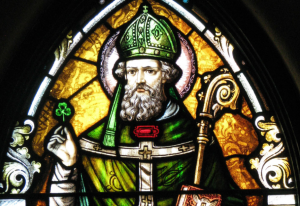St. Patrick . . . The Man, The Myths, The Legends

Thursday, March 17 th many of us will find ourselves celebrating St. Patrick’s Day, when Chicago dyes the river green, everyone best be wearing some shade of that color if they don’t wanna get pinched, and parades celebrating all things Irish abound. But what do we really know about this man we’re celebrating . . . this man who referred to himself as Patricius?
The Man . . .
For starters, some historians say his birth name was actually Maewyn Succat, although not everyone agrees. If it was then I might understand why he chose to change it. And the patron saint of Ireland isn’t even Irish. Patrick was born to wealthy parents in Roman Britain—Great Britain at a time when it was under Roman rule. It’s very probable his parents were Roman citizens—and aristocrats at that. His years of birth and death are also up for debate. After all, historical records from the fifth century aren’t all that plentiful. However, students of Irish history do believe he lived into the 490s, possibly 492 or 493, dying at the ripe old age of 120 . . . on March 17 th . Sound familiar? Even when the year varies, the day remains the same.
Patrick’s first trip to Ireland came compliments of Irish slave traders who kidnapped him from his family home and sold him upon their return. Before that time, the Apostle of Ireland wasn’t much of a believer, but the next six years of herding sheep on foreign soil strengthened his faith. After years of praying religiously, he was able to escape, heading to the coast of Ireland where he boarded a ship for Britain. At least he did unless you believe the other tale that’s told, the one that states his father’s position in the community required him to serve on the town council, a task he found so distasteful that he actually ran away from home to avoid it.
Whatever his reason for leaving, he did eventually return home and, a few years later, had a vision of a man coming to him from Ireland (this may belong in the myths and legends section . . .), a man carrying a letter which read “We appeal to you, holy servant boy, to come and walk among us.” Believing he had been summoned, Patrick returned to Ireland as a missionary and the rest, as they say, is history . . . with just a wee bit o’ blarney thrown in.
The Myths . . . and The Legends . . .
As with many historical figures, St. Patrick’s legacy grew after his death, possibly as an effort by his followers to make his rather mundane adult life sound a bit more exciting rather than as an actual recitation of facts. For example . . .
According to legend, Patrick had a walking stick or staff made from the wood of an ash tree. His custom was to stick said stick in the ground when he began to evangelize an area and to remove it when his work was done. At one such spot his message took so long to convey and the people so long to convert that the staff had actually taken root when he prepared to leave.
Although St. Patrick is often pictured with a cross in one hand and a wad of shamrocks in the other, he never mentions them in any of his writings. His earliest visual connection came in the 1680s when coins were minted that showed him holding a shamrock. Later, in 1726, a botanist named Caleb Threlkeld told the story of Patrick using the three leafed plant to illustrate the Holy Trinity. That makes perfect sense, but whether or not it’s true is again, up for debate.
You’ve probably also heard that Patrick drove the snakes from Ireland . . . which would have been a neat trick if Ireland ever had snakes. Supposedly he drove them into the sea after a herd . . . or flock . . . or whatever you call a bunch of snakes . . . attacked him as he fasted at the top of a hill. But according to naturalist Nigel Monaghan, the resident expert of history at the National Museum of Ireland in Dublin, it just isn’t so. There are no records, fossilized or otherwise, that prove a snake infestation ever occurred on the island.
The Summation and Application . . .
So, why a brief discussion of St. Patrick and his life? Well, it is St. Patrick’s Day, a holiday best known for the mandatory wearing of the green, not to mention parades and parties (and alcohol), with the occasional leprechaun thrown in for good measure. But St. Patrick’s life and legacy can also illustrate what happens when folks—famous or not—enter the afterlife. We often appreciate them far more once they depart, we often acknowledge all the good they accomplished and tend to overlook the not-so-great, and we often make them larger than life as time goes by. In other words, we won’t all become saints in the religious sense, but the people who loved us most in life may remember us that way.
About the author: Lisa Shackelford Thomas is a fourth generation member of a family that’s been in funeral service since 1926. She has been employed at Shackelford Funeral Directors in Savannah, Tennessee for over 40 years and currently serves as the manager there. Any opinions expressed here are hers and hers alone, and may or may not reflect the opinions of other Shackelford family members or staff.
The post St. Patrick . . . The Man, The Myths, The Legends appeared first on Shackelford Funeral Directors | Blog.



365 Days of Grief Support
Sign up for one year of grief messages designed to offer hope and healing during the difficult first year after a loss
Please wait
Verifying your email address
Please wait
Unsubscribing your email address
You have been unsubscribed
You will no longer receive messages from our email mailing list.
You have been subscribed
Your email address has successfully been added to our mailing list.
Something went wrong
There was an error verifying your email address. Please try again later, or re-subscribe.









